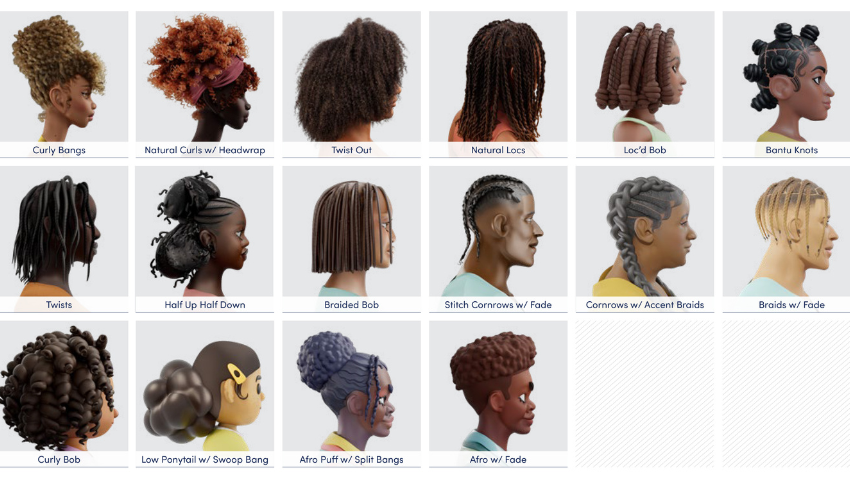Image Credit: Dove – Code My Crown
While SIGGRAPH 2024 has come and gone, the education this special event has to offer is here to stay! Grab your notebooks and prepare for a deep dive into the world of perfecting Black hair in computer graphics as we catch up with A.M. Darke and Theodore Kim, contributors of the SIGGRAPH 2024 Course “More Than Killmonger Locs: A Style Guide for Black Hair (in Computer Graphics)”.
SIGGRAPH: Your session “More Than Killmonger Locs: A Style Guide for Black Hair (in Computer Graphics)” covers the most recent advancements in the depiction of Black hair. What inspired you to present these advancements at SIGGRAPH 2024?
A.M. Darke (AM): As a game designer and the founder of the Open Source Afro Hair Library, I’ve been working on Black hair in games and 3D media for several years. It wasn’t until Dr. Kim and I started collaborating in 2020 that I came to understand the dearth of research on afro-textured hair within computer graphics. Since then, we’ve been advocating for greater recognition that human features such as “hair” and “skin” cannot be defined and then universalized based on features predominant among Europeans. Coming from an arts and humanities environment where conversations around human diversity are commonplace among scholars, I’ve been perplexed by the pushback we’ve received within the scientific graphics community over what I view as a very straightforward research problem. Studying the features of a common hair texture that has been missing from 50 years of literature isn’t provocative to me, nor is it DEI, it’s just an obvious and rich opportunity for exploration. By presenting this course, I’m hoping to fill gaps in our collective knowledge and inspire others to take a broader perspective when it comes to examining the full diversity of human features.
Theodore Kim (TK): I have worked in computer graphics for over 20 years, both as a professor and as a senior research scientist at Pixar Animation Studios. Throughout that time, I have not seen any course cover Black hair at SIGGRAPH. Blonde, straight, and wavy hair, like a Cybil Shepherd shampoo ad, yes. Black hair, no. I have been working with Prof. Darke for the last four years, and when she showed me the “Code My Crown” guide she had been developing with her other collaborators and Dove, I thought it would be perfect for SIGGRAPH, and asked if she would be interested in presenting it here.
SIGGRAPH: You mention that many aspects of the aesthetics and mechanics of Black hair remain poorly understood. How do you address this with your research and advancements shared in the Course?
AM: I point out that what amounts to diversity within computer graphics (as it relates to hair) is really not diverse at all. When you look at the last 25 years of research and examine the language of hair, the reference photos, and even the hero images heralding some kind of technological breakthrough, the imagery is striking; it’s almost exclusively straight hair of various lengths. It’s not diverse at all, not when you compare it to the imagery of the Open Source Afro Hair Library or our partner project Code My Crown — both of which are free to access for anyone interested in understanding the visual properties of Black hair textures and styles. Hairstyles, by the way, are distinct from hair textures. But when you look at the research output within the field, they are collapsed into the same thing which might contribute to a false sense of diversity.
Another important point that I make is that as a community, computer graphics doesn’t know what natural Black hair looks like. There is a seminal paper that seems to depict “African” hair, but the hair is straight, not wavy, not curly, and not kinked whatsoever. The moment I saw that image I thought, “Well this person’s hair is either chemically relaxed or heat-straightened, so what is the point of including an ‘African’ reference if the hair isn’t visually distinct from European hair?” It’s striking to me because it doesn’t take a specialist to identify that kind of issue, any Black person could point this out, making these kinds of oversights kind of embarrassing. That problem of conflating texture–Afro, and style–afro, continues in the latest research as well. The distinction is important since technically anyone — with varying degrees of effort and manipulation — can style their hair into a big spherical shape–afro, but that does not make it Afro-textured hair, as in the texture predominant among Afro-diasporic peoples.
TK: Prof. Darke and I, along with my graduate students, developed a new mechanical model for hair last year that was specifically tailored to Black hair. It turns out that if you can assume the hair you are simulating is curly, a lot of the computational challenges change. Previous approaches spent a lot of time getting the twist and torsion of a hair strand just right, and if you are looking at a piece of stick-straight hair, computing these quantities is indeed really tricky. However, on a curved piece of hair, a lot of these difficulties go away. We were able to formulate a model that was both faster and more robust than previous methods, and we published it at the Symposium on Computer Animation, where we won the Best Paper Award. This year, we present the same model to the SIGGRAPH audience.
SIGGRAPH: Tell us about “Code My Crown”. What is the hope that this guide will provide for others who are working on Black hair in their projects?
AM: The work is fully published and available. Code My Crown consists of over 200 pages of cultural and historical context for several Black hairstyles. It talks about the most popular hair typing system, started by Andre Walker and expanded upon by the natural hair community (who included curly-kinky types 3c and 4c). Included in the document are 360 photo references of each style as well as step-by-step instructions on how they were recreated in 3D. Additionally, all of the 3D hairstyles featured in Code My Crown are available for free and open source on Github. It’s extremely comprehensive and a great starting point for any researcher, designer, or developer.
SIGGRAPH: What does the future hold for the aesthetics and mechanics of Black hair in computer graphics? How do you see it evolving?
AM: Because Black hair encompasses the curliest possible human hair textures, I believe that solving for its unique properties computationally will completely break open the possibilities for realistic human hair simulation. Four years ago, I would have said it is the most challenging, a common understanding throughout the field, but with advancements Ted, Alvin, Haomiao, and I have been able to make, I’m no longer convinced that Black hair is more challenging to simulate and render. It seems this was, like so many other issues of racial diversity in our society, a matter of investment and opportunity. Some of the images we’ve been able to generate with our novel algorithms have quite literally brought me to tears — we’ve been working for four years. It really hasn’t taken long to reach these breakthroughs. Perhaps our small collaborative team is exceptionally brilliant? But really, I can only imagine what the landscape could look like if dozens upon dozens of folks turned their attention to understanding the intricacies of Black hair. The realistic and creative possibilities would be amplified for everyone, regardless of hair texture.
TK: The space of Black hairstyles is a huge, beautiful, and unexplored research area. If we can look past our past prejudices and treat it with the same scientific curiosity as we have for other hairstyles, there is lots of interesting work to be done.
SIGGRAPH: What do you hope the SIGGRAPH 2024 audience took away, personally or professionally, from your live course?
AM: I would like for our audience to examine the ways in which the persistent centering of white Europeans limits our collective possibilities for technical advancement, creative expression, and scholarly inquiry. I would like for us to stop centering straight hair (and pale skin) as the standard by which we prove the efficacy of our solutions, with mediocre renders of curly hair being a kind of half-hearted bonus. Black hair is not an issue of DEI. It’s not an outlier. It encompasses the hair textures of over a billion people — not all of whom are Black. Relatedly, I want reviewers to stop insisting or even suggesting that hair algorithms need to demonstrate their efficacy on straight hair when that is only one of many hair types, and it’s overrepresented in the research.
I hope that people can come around to the idea that examining humanity beyond the most socially and politically dominant groups — who, despite their concentration in positions of influence and authority, do not constitute a global majority — is not a niche idea that benefits a marginalized few, it’s simply good scientific practice. And it benefits everyone.
TK: I second A.M.’s sentiment that people should stop expecting that every advance in hair research must take the form of a newer, even more universal, more-uber-than-uber-model for all hair types that is more all-encompassing than the last. Because there has been so little research into Black hair, the place to start is the development of a set of bespoke models that carefully investigate the aesthetics of this type of hair. As long as their limitations are clearly labeled, there is nothing wrong with highly targeted algorithms. I would be suspicious of an algorithm that claims to work equally well on all types of hair, just like I would be suspicious of a shampoo that claims it’s the all-in-one solution for everybody’s hair.
The in-person event in Denver may be over, but SIGGRAPH 2024 lives on with Virtual Access! Dive into on-demand recordings featuring the latest tech advancements, groundbreaking research, and exclusive interviews. Don’t miss out on fan-favorite programs like Real-Time Live! and Keynote Presentations that stretch the imagination. Register now and explore select content available through 1 September!

A.M. Darke is an artist and associate professor of games and new media at UC Santa Cruz. Through critical games and experimental media, Darke examines Blackness through a technocultural lens. S/he has won multiple awards for her creative practice in the arts, as well as her contributions to computer graphics, where she has co-authored the first algorithms dedicated to the simulation of afro-textured hair. Darke is the founder of the Open Source Afro Hair Library, a free resource of assets celebrating Black hair in three dimensions. Darke has a BA in design and an MFA in media arts, both from UCLA. Her work has been widely exhibited at festivals and galleries around the world, and featured in a variety of publications, such as The New York Times, VICE, and NPR.

Theodore Kim is an professor in computer science at Yale University, where he investigates biomechanical solids like hair and skin, fluid dynamics, and selected topics in geometry. Previously, he was a senior research scientist at Pixar Animation Studios. He received a Ph.D. from the University of North Carolina in 2006, and a BS from Cornell University in 2001, both in computer science. He has received the NSF CAREER Award, multiple Best Paper awards, and two Scientific and Technical Academy Awards. His algorithms have appeared in over 20 films, and he has screen credits in “Cars 3”, “Coco”, “Incredibles 2”, and “Toy Story 4”.



